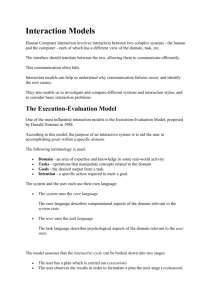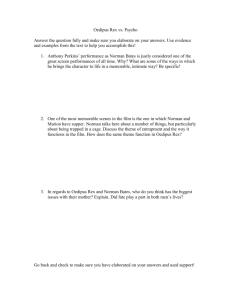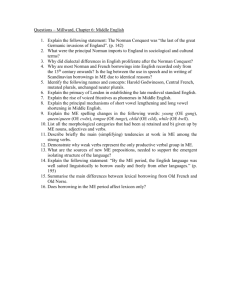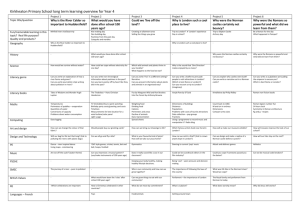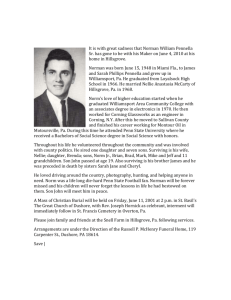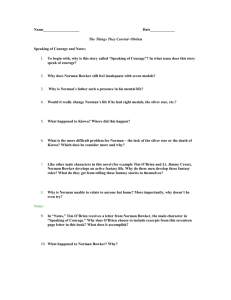Parlour Scene Example Essay
advertisement
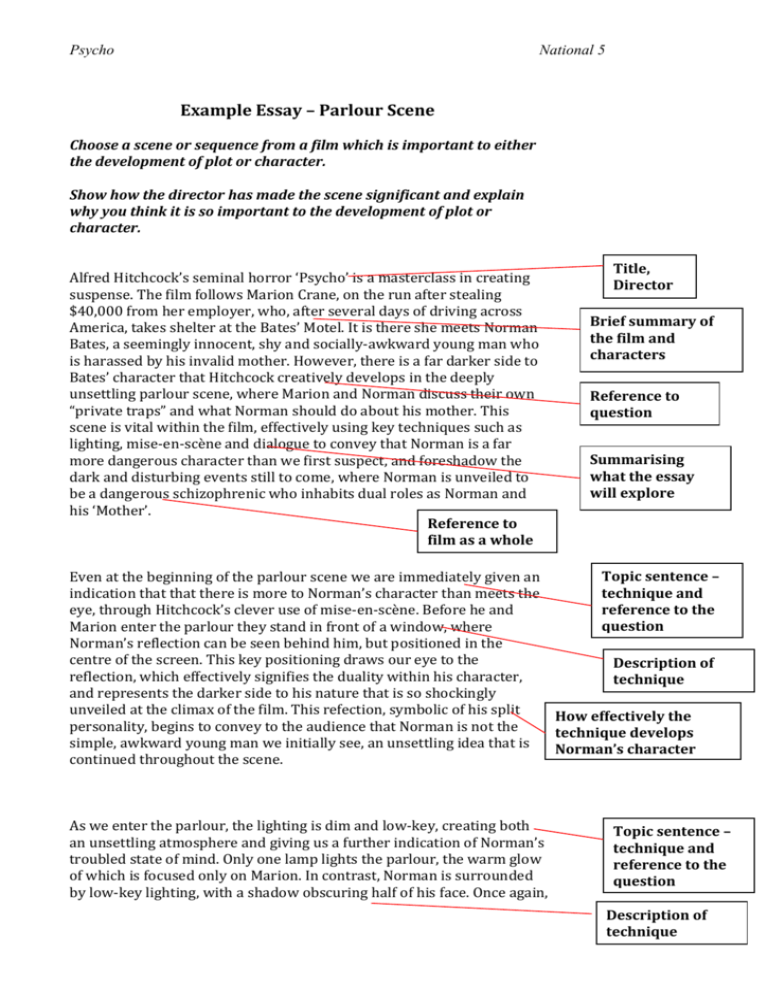
Psycho National 5 Example Essay – Parlour Scene Choose a scene or sequence from a film which is important to either the development of plot or character. Show how the director has made the scene significant and explain why you think it is so important to the development of plot or character. Alfred Hitchcock’s seminal horror ‘Psycho’ is a masterclass in creating suspense. The film follows Marion Crane, on the run after stealing $40,000 from her employer, who, after several days of driving across America, takes shelter at the Bates’ Motel. It is there she meets Norman Bates, a seemingly innocent, shy and socially-awkward young man who is harassed by his invalid mother. However, there is a far darker side to Bates’ character that Hitchcock creatively develops in the deeply unsettling parlour scene, where Marion and Norman discuss their own “private traps” and what Norman should do about his mother. This scene is vital within the film, effectively using key techniques such as lighting, mise-en-scène and dialogue to convey that Norman is a far more dangerous character than we first suspect, and foreshadow the dark and disturbing events still to come, where Norman is unveiled to be a dangerous schizophrenic who inhabits dual roles as Norman and his ‘Mother’. Reference to film as a whole Title, Director Brief summary of the film and characters Reference to question Summarising what the essay will explore Topic sentence – Even at the beginning of the parlour scene we are immediately given an technique and indication that that there is more to Norman’s character than meets the reference to the eye, through Hitchcock’s clever use of mise-en-scène. Before he and question Marion enter the parlour they stand in front of a window, where Norman’s reflection can be seen behind him, but positioned in the centre of the screen. This key positioning draws our eye to the Description of reflection, which effectively signifies the duality within his character, technique and represents the darker side to his nature that is so shockingly unveiled at the climax of the film. This refection, symbolic of his split How effectively the personality, begins to convey to the audience that Norman is not the technique develops simple, awkward young man we initially see, an unsettling idea that is Norman’s character continued throughout the scene. As we enter the parlour, the lighting is dim and low-key, creating both an unsettling atmosphere and giving us a further indication of Norman’s troubled state of mind. Only one lamp lights the parlour, the warm glow of which is focused only on Marion. In contrast, Norman is surrounded by low-key lighting, with a shadow obscuring half of his face. Once again, Topic sentence – technique and reference to the question Description of technique Psycho National 5 this is a clear indication to the dual personality Norman inhabits, and as the conversation between he Marion becomes more tense, this dark shadow becomes increasingly pronounced – effectively conveying the darker side to Norman that up until now has been hidden behind his awkward and earnest mannerisms. How effectively the technique develops Norman’s character Topic sentence – technique and reference to the question The conversation that Marion and Norman engage in is also incredibly effective in developing his character. As they both discuss their own “personal traps” it becomes clear that Norman has a difficult relationship with his ‘Mother’. However, when Marion suggests putting her ”someplace” – a clear reference to a care home or asylum – Norman reacts with a chilling rage. His dialogue becomes short and sharp, using sibilance to convey his sudden anger. At this moment, the affable young man we first meet disappears and is replaced by a far darker and more dangerous figure, once again foreshadowing the terrible unveiling of his deadly nature at the end of the film. Description of technique How effectively the technique develops Norman’s character As well as this darker turn in dialogue, the setting of the parlour begins to take a far more sinister appearance, emphasising this deadlier side of Norman as well as his feelings of confinement and repression. The miseen-scène within the scene, particularly the use of stuffed birds, creates a both odd and ominous setting for Marion and Norman, with the birds – all birds of prey – looming menacingly above Norman, as if poised to attack Marion. These birds become symbolic of Norman’s darker side, but as well as that, represent his self-imposed confinement. The birds, usually such symbols of freedom, are instead here trapped within their own bodies. Norman with his hobby of taxidermy has unconsciously surrounded himself with objects that signify his own lack of freedom and the suppression that his ‘Mother’ imposes on him. Often overshadowed by the more famous shower scene, the parlour sequence is probably the most fascinating within ‘Psycho’. In this scene, subtlety is key, and Hitchcock uses lighting, mise-en-scène and dialogue effectively to hint at and develop the darker side of Norman’s character that is so vital to the film as a whole. This unsettling scene acts as a gateway for the rest of the film, and it is only looking back that we see how much is foreshadowed here, from Norman’s dual personality in the reflection and use of low-key lighting, to his clear suppression embodied in his beloved stuffed birds, frozen in flight yet still so symbolic of the danger that they – and he - represent. Topic sentence – technique and reference to the question Description of technique How effectively the technique develops Norman’s character Title, Director Summarising what the essay has explored Reference to question How effectively the technique develops Norman’s character
